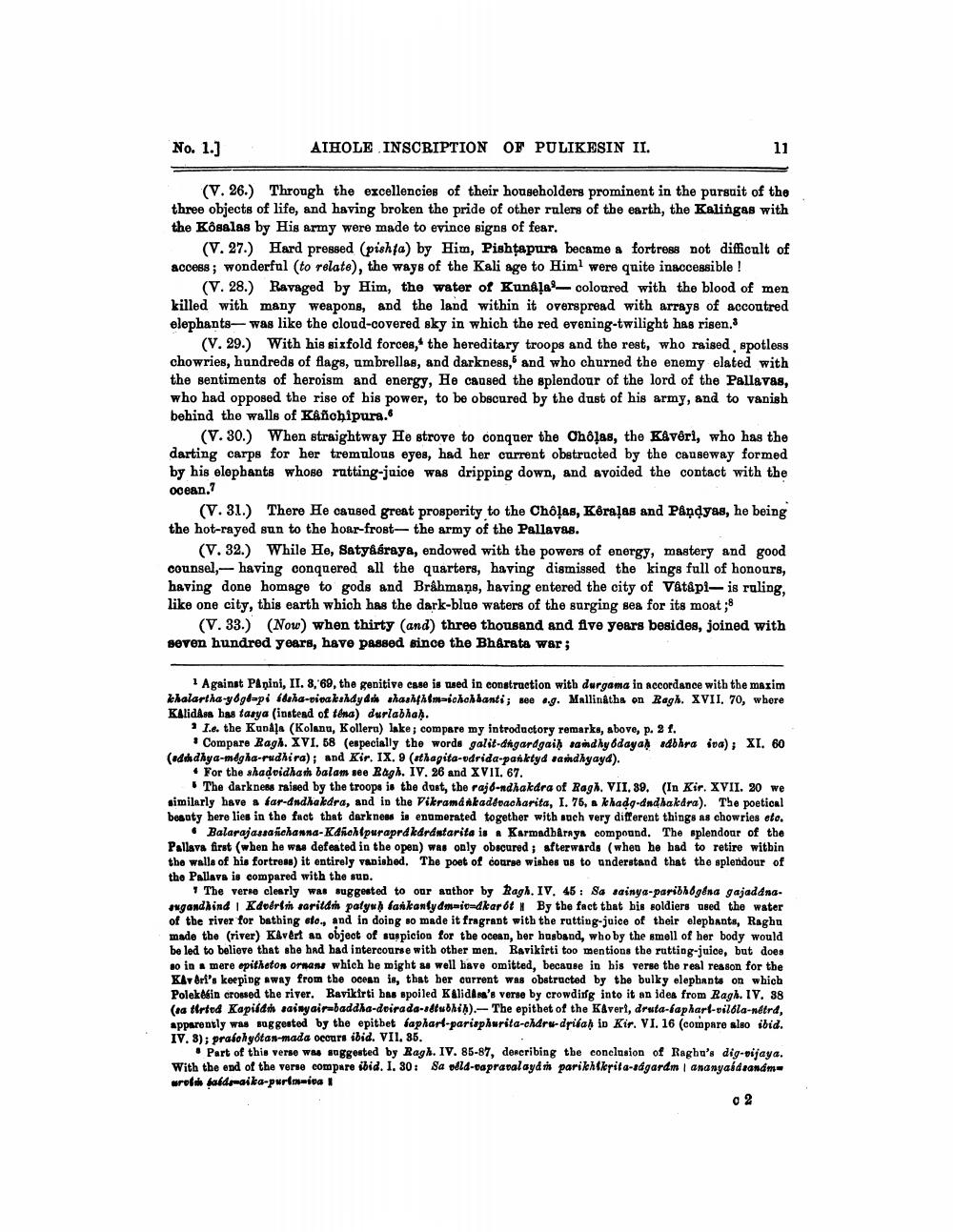________________
No. 1.]
AIHOLE INSCRIPTION OF PULIKESIN II.
(V. 26.) Through the excellencies of their householders prominent in the pursuit of the three objects of life, and having broken the pride of other rulers of the earth, the Kalingas with the Kösalas by His army were made to evince signs of fear.
(V. 27.) Hard pressed (pisha) by Him, Pishtapura became a fortress not difficult of access; wonderful (to relate), the ways of the Kali age to Him? were quite inaccessible !
(V. 28.) Ravaged by Him, the water of Kunala-coloured with the blood of men killed with many weapons, and the land within it overspread with arrays of accoutred elephants-was like the cloud-covered sky in which the red evening-twilight has risen.
(V. 29.) With his sixfold foroon, the hereditary troops and the rest, who raised spotless chowries, hundreds of flags, umbrellas, and darkness, and who churned the enemy elated with the sentiments of heroism and energy, He caused the splendour of the lord of the Pallavas, who had opposed the rise of his power, to be obscured by the dust of his army, and to vanish behind the walls of Kanchipura.
(V. 30.) When straightway He strove to conquer the Cholas, the Kaveri, who has the darting carps for her tremalons eyes, had her current obstructed by the causeway formed by his elephants whose ratting-juice was dripping down, and avoided the contact with the ocean.
(V.31.) There He caused great prosperity to the Chôļas, Koraļas and Pandyas, he being the hot-rayed sun to the hoar-frost-the army of the Pallavas.
(V. 32.) While He, Satyasraya, endowed with the powers of energy, mastery and good counsel, - having conquered all the quarters, having dismissed the kings full of honours, having done homage to gods and Brahmans, having entered the city of Våtåpi-is ruling, like one city, this earth which has the dark blue waters of the surging sea for its moat;8
(V. 33.) (Now when thirty (and) three thousand and five years besides, joined with seven hundred years, have passed since the Bharata war;
1 Against Papini, II. 8, 69, the genitive case is used in construction with durgama in accordance with the maxim khalartha-y@gdapi kesha-pitakshay duo shashtim-ichohlanti; see e.g. Mallinátha on Ragh. XVII. 70, where KAlidAsa bas tasya (instead of tena) durlabhah.
11.6. the Kupaļa (Kolanu, Kolleru) lake; compare my introductory remarks, above, p. 21.
• Compare Ragh. XVI. 58 (especially the words galit-angardgain sandhy @dayah adbira iva), XL. 60 (odd dhya-megha-rudhira); and Kir. IX. 9 (athagita-odrida-panktyd sandhyayd).
For the shadoidhar Dalam see Bagh. iv. 26 and XVII. 67.
The darkness raised by the troops is the dust, the rajo-ndhakara of Ragh. VII. 89. (In Kir. XVII. 20 we similarly have a far-dndhakara, and in the Vikrama Akad&oacharita, I. 76, a khadg-dndhakara). The poetical beauty bere lies in the fact that darkness is enumerated together with such very different things as chowries elo.
• Balarajassatichanna-Kdñichtpuraprdkarantarita is a Karmadbaraya compound. The splendour of the Pallava first (when he was defeated in the open) was only obscured; afterwards (when he had to retire within the walls of his fortress) it entirely vanished. The poet of course wishes us to understand that the splendour of the Pallava is compared with the sun.
The verse clearly was suggested to our author by Ragh. IV. 45: Sa sainya-paribhogéna gajadanaengandhind I Kdvéri saritan palyn lankantydmair=dkarót By the fact that his soldiers used the water of the river for bathing sto., and in doing so made it fragrant with the rutting-juice of their elephants, Raghu made the (river) Kavert an object of suspicion for the ocean, her husband, who by the smell of her body would be led to believe that she had bad intercourse with other men. Ravikirti too mentions the rutting-juice, but does so in mere epitheton ornan which he might as well have omitted, because in his verse the real reason for the KA Ori's keeping away from the ocean is, that her current was obstructed by the bulky elephants on which PolokMin crossed the river. Ravikirti bas spoiled Kalidasa's verse by crowdirfg into it an idea from Ragh. IV. 38 (na tlrtod Kapildu sainyairabaddha-doirada-dubkih).- The epithet of the Kaveri, druta-laphart-villa-nétrd, apparently was suggested by the epitbet laphart-parispurita-chdrw-dribah ip Kir. VI. 16 (compare also ibid. IV. 3); prabohyótan-mada occurs ibid. VII, 85.
. Part of this verse was suggested by Ragh. IV. 85-87, describing the conclusion of Raghu's dig-vijaya. With the end of the verse compare ibid. I. 30: Sa odld-vapraralaydu parikhlkrita-adgardm | ananyabdiandmurofnih bald-aika-purn-ina !
02




